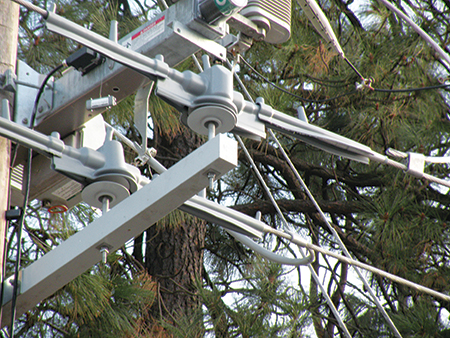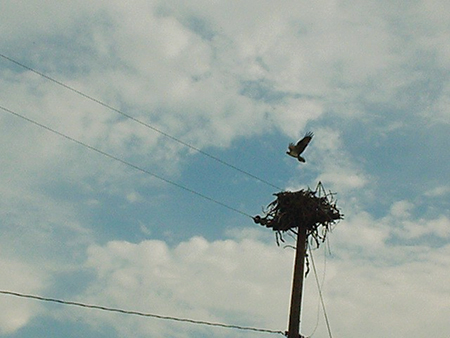You hear about it every day: the grid is evolving further and faster with each passing service hour. There are new methods for setting prices, new devices for tracking peak usage. In every aspect of its operation, from the way it collects information to the way it distributes electricity, the grid is getting ‘smarter.’
However, there are other effective ways for a utility to ‘get smart’ about its service, on the ground and out in the field. Many factors can affect a system’s reliability, from employee training to the transformers, but oftentimes the best place to begin the evaluation of your system is with the physical lines themselves.
That’s how Avista Utilities began their review in 2008. The company has worked in renewable energy in the Pacific Northwest since 1889, and now provides electric service to 361,000 customers and natural gas to 320,000 customers over a 30,000 square mile (77,700 square kilometer) service territory. Their customers include business, industry, universities, and consumers in eastern Washington, northern Idaho, and parts of southern and eastern Oregon.
“We decided to undertake an overhaul and simplification of our overhead construction standards,” explained John T. Dunlap, Senior Electrical Engineer at Avista, “We’ve had some of our networks for more than a century, and you don’t stay in business that long without always working to meet your customers’ energy needs more reliably and responsibly. We wanted to take a long look at our systems and see how we could reduce the number of necessary service calls and minimize failures.”
Avista discovered that by combining fiberglass arms and Hendrix Vise Top insulators they could improve reliability, reduce inventory, and simplify their overhead construction standards.

Analyzing the Findings
“One of the first conclusions we came to was that the weakest link in our system, the piece that had us out on service calls most often, was our wooden cross arms,” said Dunlap. “The cross arm was almost always the first thing to fail on the distribution structures and it resulted in most of our initial service calls. By replacing the wooden arms with fiberglass, we could eliminate a lot of those issues.”
“Next, we realized that we could improve our wildlife protection through the elimination of double arms,” continued Dunlap, “Here in the northwest, ospreys are common, and a lot of our service territory runs along the rivers and waters where they live. It’s essential for their safety that we prevent them from nesting on our lines. That also helps ensure the reliability of our electric system by eliminating some power outages, electrocutions and fires caused from nests.

“Without double arms, we also save on the labor and supply costs of constructing nesting platforms and relocating nests.” However, in order to eliminate double arms, Avista needed stronger cross arms for dead-ending, as well as stronger tangent arms and cross arm pins to withstand the tensions resulting from the necessary angles.
Lastly, Avista decided to replace their porcelain insulators with Hendrix Vise Top insulators. Hendrix Vise Top insulators incorporate a clamping mechanism into the top of the insulator to provide quick and easy conductor installation without the need for additional tie products. Molded from a proprietary blend of gray, track resistant, high density polyethylene, they also offer higher impact, puncture, and UV resistance than porcelain alternatives.
“It’s much quicker and easier to install than a tie-top insulator,” explained Ken Woo, Director of Sales, Molded Products, at Hendrix Wire & Cable, “You don’t need to purchase an additional tie to secure your conductor onto the insulator, and you don’t need to train the folks who are performing the installation to use those ties. With these insulators, you just turn the bolt and install.”
“In addition, the Vise Top can be used with all conductor types, bare or covered. It also conforms to the electrical and mechanical requirements of ANSI C29.5 and C29.6. It’s much, much lighter than the equivalent porcelain product, and because it exceeds all the ANSI electrical and mechanical performance requirements, it’ll perform a lot better as well.”
The team at Avista was very impressed by the benefits of this product. “By using the Vise Top insulators, we were able to eliminate 40 different stock items,” said Dunlap, “We can use one insulator for 35 kV, and one for both 15 kV and 25 kV. Since the Vise Tops simply clamp on, we no longer need to purchase and stock a large amount of ties. We’ve gone to Hendrix Vise Top insulators exclusively now, and our storekeepers are very happy. Not only does this keep our employees satisfied, it’s also excellent for us from a cost management perspective, which is a benefit to customers.”
Once Avista had identified these separate solutions and goals, they had to create a cohesive plan for integrating them into the existing system and future installations. This is where Hendrix came in.
Formulating the Solution
“The most critical part of this overhaul,” explained Dunlap, “was that all these new materials worked together and were applied correctly. After all, we were rewriting the foundation of our construction standards. It was essential that the new standards provided a concise, easily applicable template that would ensure we consistently meet code in the years to come.”
“There are a lot of variables and questions involved in formulating these standards,” he continued. “For example, how much angle can we put on these pins for a given conductor size and span length?” To answer questions like these and provide accurate, application-specific information, Hendrix operates an engineering lab at its facilities in Milford, New Hampshire. The lab is capable of performing industry design tests as well as routine electrical and physical testing, so that customers can know what they need to ahead of time.
For this job, Avista sent Hendrix an assortment of cross arm pins and other materials for testing. “We performed a variety of tests for Avista,” said Woo, “For instance, our technical staff performed Finite Element Analysis (FEA), a mechanical stress analysis which determined if the pins and insulators we provided would hold up under the stresses of moderate or severe angle applications. We also performed mechanical tests, such as Cantilever strength testing, to simulate the angles that these pins would be installed under. We ensured that our products were up to certification and exceed 3,000 pounds of force without any breakage.”
Hendrix also provides post-mortem analysis after damage or failure in the field, as well as assistance in designing new applications. “Hendrix offers all of these capabilities in-house because many utilities do not have test facilities and labs of their own,” explained Woo. “When we’re able to simulate an application before it’s out on the overhead line, it gives our customers that much more assurance that the product will perform. Electric utilities invest a lot in their lines, and it’s important that they be able to predict how they will work. We’re here to help them to do that.”
Avista was very pleased with the knowledge and support that Hendrix’s testing provided. Dunlap said, “We’ve worked with Hendrix on their underground cables for years, and we just have such a high trust level with them. They are tremendously supportive. If I’ve got an issue, they come out. They call on us. They solve the problem. I just sent Ken Woo several of the cross arm pins we were planning to use, and the folks at Hendrix did the rest. By the time they were done, we knew exactly how much tension to design for with our combination of vise tops and cross arm pins.”
With the results of the testing, Avista was able to move forward with clear new construction standards. Their lines are now simpler to build, less likely to need repair, and composed of fewer pieces.
Conclusion
Avista is now prepared to take their electrical distribution to the next level. The new fiberglass arms provide a sturdier, more resilient replacement for the old wooden arms. The company will conserve costs and the environment by reducing the necessity for nesting platforms. Their streamlined stock is now easier to manage and more cost-effective.
“This is exactly the sort of project we’re happy to undertake and proud to support,” said Woo. “Hendrix was founded to manufacture innovative, space-saving, and cost-saving products like the Vise Top insulator, but a large part of our reputation is also built on excellent engineering and customer service. It was very rewarding to combine these two core competencies and create a more efficient, environmentally friendly network with Avista.”
“I could not be happier with the way this project turned out,” said Dunlap, “We have eliminated over 40 stock items, improved our wildlife protection, produced superior new construction standards, and removed the weakest links in our system. We believe that this new combination of fiberglass arms and Hendrix Vise Tops will get us through three inspection cycles, or over 50 years. Avista is proud to better serve our customers with the most advanced and efficient electrical distribution system we can offer.”
About the author
 Tom Wilson, VP and General Manager, Molded Products, has more than 25 years’ experience serving the utility industry and 35 years in and around wire and cable. Prior to Hendrix, Tom held positions at Champlain Cable Corporation in which he was responsible for data transmission, aerospace and control cable. Before wire and cable Tom worked at Willson Safety Products where he was involved with the National Institute of Occupational Safety and Health and helped establish the Safety Equipment Institute as a third party quality assurance mechanism for the safety equipment industry. He has worked in various capacities with plastic injection molding for over 15 years. He received his BA from Saint Michael’s College in Winooski, VT. He also studied statistics and quality at the University of West Virginia.
Tom Wilson, VP and General Manager, Molded Products, has more than 25 years’ experience serving the utility industry and 35 years in and around wire and cable. Prior to Hendrix, Tom held positions at Champlain Cable Corporation in which he was responsible for data transmission, aerospace and control cable. Before wire and cable Tom worked at Willson Safety Products where he was involved with the National Institute of Occupational Safety and Health and helped establish the Safety Equipment Institute as a third party quality assurance mechanism for the safety equipment industry. He has worked in various capacities with plastic injection molding for over 15 years. He received his BA from Saint Michael’s College in Winooski, VT. He also studied statistics and quality at the University of West Virginia.







